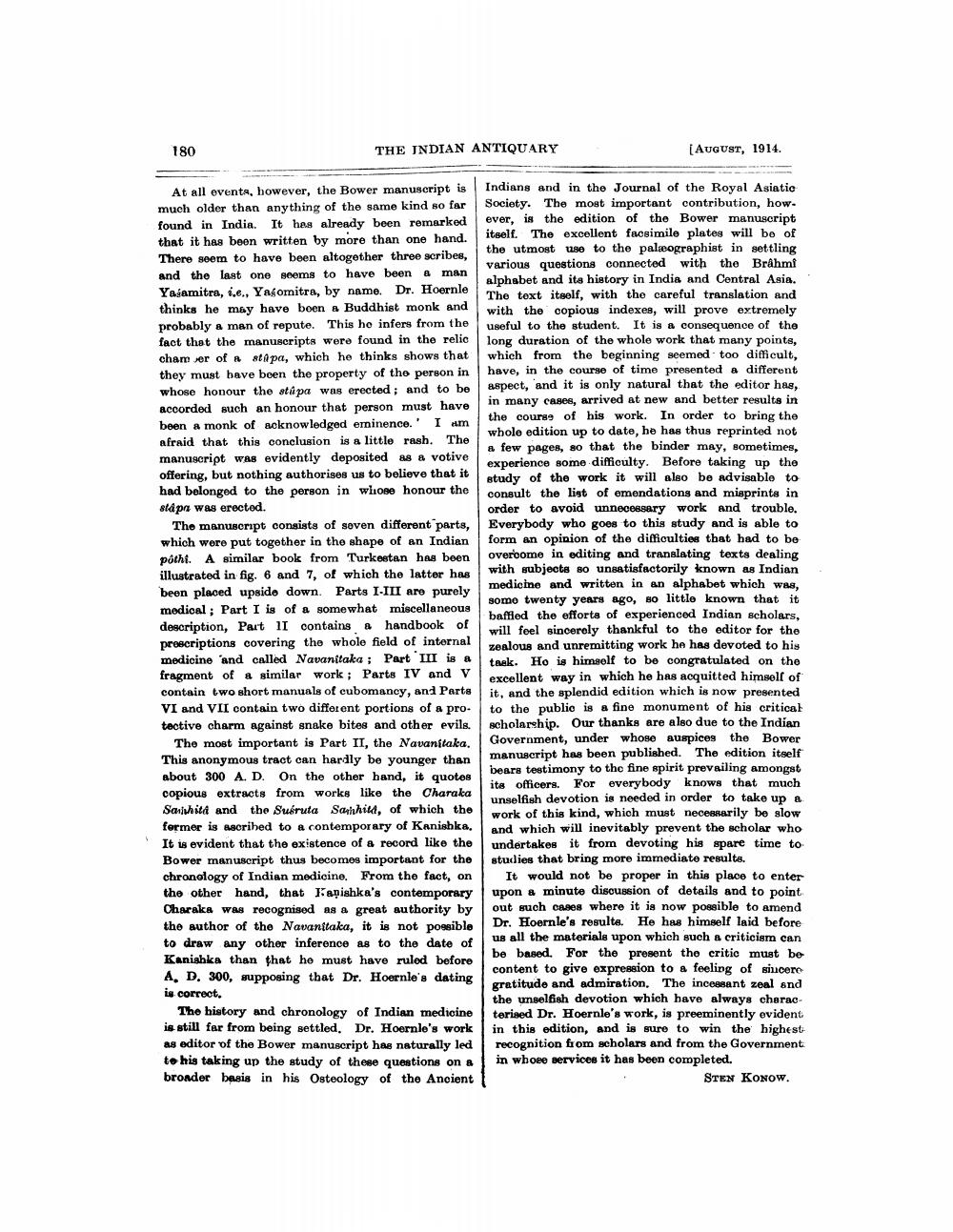________________
180
THE INDIAN ANTIQUARY
(AUGUST, 1914.
At all events, however, the Bower manuscript is Indians and in the Journal of the Royal Asiatic much older than anything of the same kind so far Society. The most important contribution, howfound in India. It has already been remarked
ever, is the edition of the Bower manuscript
itself. The excellent facsimile plates will be of that it has been written by more than one hand.
the utmost use to the palæographist in settling There seem to have been altogether three scribes,
various questions connected with the Brahmf and the last one seems to have been a man
alphabet and its history in India and Central Asia. Yasamitra, i.e., Yafomitra, by name. Dr. Hoernle
The text itself, with the careful translation and thinks he may have been a Buddhist monk and
with the copious indexes, will prove extremely probably a man of repute. This ho infers from the
useful to the student. It is a consequence of the fact that the manuscripts were found in the relic long duration of the whole work that many points, cham er of a stapa, which he thinks shows that which from the beginning seemed too difficult, they must have been the property of tho person in have, in the course of time presented a different whose honour the stúpa was erected; and to be
aspect, and it is only natural that the editor has,
in many cases, arrived at new and better results in acoorded such an honour that person must have
the course of his work. In order to bring the been a monk of acknowledged erinence.' I am
whole edition up to date, he has thus reprinted not afraid that this conclusion is a little rash. The
a few pages, so that the binder may, sometimes, manuscript was evidently deposited as a votive
experience some difficulty. Before taking up the offering, but nothing authorises us to believe that it
study of the work it will also be advisable to had belonged to the person in whose honour the
consult the list of emendations and misprinta in slåpa was erected.
order to avoid unnecessary work and trouble. The manuscript consists of seven different parts, Everybody who goes to this study and is able to which were put together in the shape of an Indian form an opinion of the difficulties that had to be pótht. A similar book from Turkestan has been
Overoome in editing and translating texts dealing illustrated in fig. 6 and 7, of which the latter has
with subjects so unsatisfactorily known as Indian
medicine and written in an alphabet which was, been placed upside down. Parts I-III are purely
somo twenty years ago, so little known that it medical : Part I is of a somewhat miscellaneous
baffled the efforts of experienced Indian scholars, description, Part II contains a handbook of
will feel sincerely thankful to the editor for the prescriptions covering the whole field of internal
zealous and unremitting work he has devoted to his medicine and called Navanitaka ; Part III is a
taek. Ho is himself to be congratulated on the fragment of a similar work; Parts IV and V
excellent way in which he has acquitted himself of contain two short manuals of cubomancy, and Parts it, and the splendid edition which is now presented VI and VII contain two different portions of a pro- to the public is a fine monument of his critical tective charm against snake bites and other evils. scholarship. Our thanks are also due to the Indian The most important is Part II, the Navanitaka.
Government, under whose auspices the Bower This anonymous tract can hardly be younger than
manuscript has been published. The edition itself about 300 A.D. On the other hand, it quotes
bears testimony to the fine spirit prevailing amongst
its officers. For everybody knows that much copious extracts from works like the Charaka
unselfish devotion is needed in order to take up a Sanishita and the Suéruta Sannhild, of which the
work of this kind, which must necessarily be slow former is ascribed to a contemporary of Kanishka, and which will inevitably prevent the scholar who It is evident that the existence of a record like the undertakes it from devoting his spare time to Bower manuscript thus becomes important for the studies that bring more immediate results. chronology of Indian medicine. From the fact, on 1 It would not be proper in this place to enter the other hand, that Kapishka's contemporary upon a minuto discussion of details and to point Charaka was recognised as a great authority by | out such cases where it is now possible to amend the author of the Navanitaka, it is not possible
Dr. Hoernle's results. He has himself laid before to draw any other inference as to the date of
us all the materials upon which such a criticism can Kanishka than that he must have ruled before
be based. For the present the critic must be A. D. 300, supposing that Dr. Hoernle's dating
content to give expression to a feeling of sincere
gratitude and admiration. The incessant zeal and is correct.
the unselfish devotion which have always characThe history and chronology of Indian medicine terised Dr. Hoernle's work, is preeminently evident is still far from being settled. Dr. Hoernle's work in this edition, and is sure to win the highest as editor of the Bower manuscript has naturally led recognition from scholars and from the Government to his taking up the study of these questions on a in whore services it has been completed. bronder basis in his Osteology of the Ancient
STEN KONOW.




